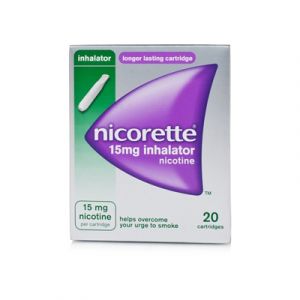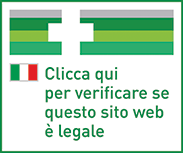Ship in Europe, Find out rates!

Nicorette Inhaler 20 Single Dose Vials 15 mg
JOHNSON & JOHNSON
Nicorette Inhaler 20 Single-dose Vials 15 mg Treatment for smoking cessation. Relieves withdrawal symptoms. It helps to reduce the addiction to smoking and, consequently, the number of cigarettes smoked.
Active principles
NICORETTE 10 mg solution for inhalation Each container contains • active ingredient: nicotine 10 mg. NICORETTE 15 mg solution for inhalation Each container contains • active ingredient: 15 mg nicotine.
Excipients
Levomenthol, porous filter.
Contraindications
Hypersensitivity to nicotine or to any of the excipients listed in section 6.1 NICORETTE should not be administered in the following cases: • recent myocardial infarction (within 3 months); • unstable or aggravated angina pectoris; • Prinzmetal's angina; • severe cardiac arrhythmias; • acute stroke; • children and adolescents under the age of 18; • pregnancy and lactation (see section 4.6); • non-smokers.
Dosage
Posology Adults and the elderly The dose is ad libitum, ie to be defined on an individual basis, according to the patient's need to reduce withdrawal symptoms associated with smoking cessation. NICORETTE should be used when the patient feels the need to smoke a cigarette or when other withdrawal symptoms appear. NICORETTE 10 mg inhalation solution To effectively control withdrawal symptoms associated with smoking cessation, from no less than 6 containers per day to no more than 12 containers per day. NICORETTE 15 mg inhalation solution To effectively control withdrawal symptoms associated with smoking cessation, from no less than 3 containers per day to no more than 6 containers per day. NICORETTE should be used like a cigarette in order to mimic the gestures associated with the habit of smoking. Studies show that different inhalation techniques give similar effects, deep inhalation (cigarette smoker's way) or shallow aspiration (pipe smoker's way). The amount of nicotine released from one inhalation is less than that from cigarette smoke. If craving relief is not enough, increase the frequency and / or size of the puffs. Each 10 mg cartridge replaces approximately 3–4 cigarettes. Each 15 mg cartridge replaces approximately 7–8 cigarettes. The number, frequency, inhalation / aspiration time and technique vary individually. The amount of nicotine released by NICORETTE can be decreased in a cold environment. Therefore it should not be used below 15 ° C. The recommended duration of treatment is 3 months. After this period, the daily dose should be gradually reduced over the next 6–8 weeks. The medicine should not be used for more than 6 months. Pediatric population The safety and efficacy in children and adolescents less than 18 years of age have not yet been established. Method of administration Inhalation route.
storage
Store at a temperature not exceeding 25 ° C.
Warnings and Precautions
Nicotine administration should be temporarily interrupted if any symptoms of overdose occur (see section 4.9). If symptoms of nicotine overdose persist, nicotine intake should be decreased by both frequency of administration and dose reduction. When starting treatment, the patient should stop smoking immediately. It is important that therapy is supported by other activities to facilitate smoking cessation. Patients who continue to smoke despite NICORETTE therapy may experience side effects due to nicotine concentrations higher than those taken with the drug alone (see section 4.9). A risk – benefit assessment by a competent physician is required for patients with the following conditions : • moderate and severe hepatic insufficiency and / or severe renal insufficiency. Use with caution in such patients as clearance of nicotine or its metabolites may be reduced with a potential for increased adverse effects; • kidney disease and dialysis. Use with caution in such smokers and hemodialysis patients as elevated nicotine levels have been observed. • esophagitis and / or gastric or peptic ulcers. Use with caution in such patients as nicotine can worsen the symptoms of these conditions; • severe cardiovascular diseases (eg peripheral occlusive arteriopathies, cerebrovascular diseases, heart failure), vasospasms and uncontrolled hypertension or peripheral vascular diseases. Such patients should be encouraged to quit smoking with non-pharmacological interventions (such as counseling); if this is not enough, NICORETTE can be considered. As safety data in this patient group are limited, treatment should only be initiated with caution; • uncontrolled hyperthyroidism or pheochromocytoma. Use with caution in such patients as nicotine causes the release of catecholamines; • diabetes mellitus. Such patients should be advised to monitor their blood sugar levels more frequently than usual because, when smoking is stopped and nicotine replacement therapy (NRT) is started, nicotine-induced catecholamine release is reduced and this can affect carbohydrate metabolism. • chronic throat diseases and bronchospasm. Use NICORETTE with caution in such patients. Stopping smoking, with or without nicotine substitutes, may alter the pharmacokinetics of some concomitantly administered drugs (see section 4.5). Pediatric population There is a risk of poisoning if a child swallows, chews or inhales the nicotine cartridge (both used and unused) (see section 4.9).
Interactions
Clinically relevant interactions between nicotine replacement therapy and other medicinal products have not been definitively established. However, nicotine has the potential to increase the haemodynamic effects of adenosine, such as increased blood pressure, heart rate and also increased pain response (such as chest pain, angina pectoris) caused by adenosine administration. • acetominophen, caffeine, imipramine, oxazepam, pentazocine, propranolol, theophylline, due to the inhibition of liver enzymes; • insulin, due to increased subcutaneous absorption of insulin; • adrenergic antagonists (prazosin, labetalol) and adrenergic agonists (isoprenaline, phenylephrine), due to the decrease in the circulation of catecholamines caused by the cessation of smoking. In such cases it may be necessary to reduce the dose upon cessation of smoking.
Side effects
NICORETTE can cause undesirable effects similar to those associated with nicotine administered by other routes. Most of the undesirable effects experienced by subjects occur during the first phase of treatment and are mainly dose dependent. Mouth and throat irritation may occur, however most people adapt with continued use. Adverse Reactions Reported in Clinical Trials The safety of nicotine from clinical trials is based on data from a meta-analysis of randomized clinical trials for the treatment of smoking cessation. Table 1 lists adverse reactions reported with a frequency ≥1%, identified from a meta-analysis of clinical trial data with oral nicotine formulations, more frequently with active treatment than with placebo treatment.
* Systemic effect Adverse reactions reported from post-marketing experience Undesirable effects collected from post-marketing experience are reported according to frequency categories using the following convention: very common (≥ 1/10); common (≥ 1/100 and <1/10); uncommon (≥ 1 / 1,000 and <1/100); rare (≥ 1/10,000 and <1 / 1,000); very rare (<1 / 10,000); not known (frequency cannot be estimated from the available data). Adverse reactions reported during post-marketing experience with oral nicotine formulations estimated based on frequency category from clinical trials are presented in Table 2
Cardiac disorders Uncommon Palpitations *, tachycardia *. Eye disorders Not known Vision blurred, lacrimation increased. Gastrointestinal disorders Common Diarrhea Uncommon Eructation, glossitis, oral mucosal blisters, oral paraesthesia. Rare Dysphagia, oral hypoesthesia, retching. Not known Dry throat, gastrointestinal upset *, lip pain. General disorders and administration site conditions Uncommon Asthenia *, chest discomfort *, chest pain *, malaise *. Immune system disorders Not known Anaphylactic reaction * Psychiatric disorders Uncommon Abnormal dreams * Respiratory, thoracic and mediastinal disorders Uncommon Bronchospasm, dysphonia, dyspnoea *, nasal congestion, oropharyngeal pain, sneezing, throat tightness. Skin and subcutaneous tissue disorders Uncommon Hyperhidrosis *, pruritus *, rash *, urticaria *. Not known Angioedema *, erythema *. Vascular disorders Uncommon Flushing *, hypertension *.* Systemic effect Some symptoms, such as dizziness, headache and insomnia, can be related to the symptoms that appear with stopping smoking. After smoking cessation, an increase in ulcerative canker sores may be found. Causation is unclear. A permanence of nicotine addiction may occur. Reporting of suspected adverse reactions Reporting suspected adverse reactions that occur after authorization of the medicinal product is important, as it allows continuous monitoring of the benefit / risk ratio of the medicinal product. Healthcare professionals are asked to report any suspected adverse reactions via the national reporting system at "www.agenziafarmaco.gov.it/it/responsabili".
Overdose
If the patient has very low nicotine-dependence or uses other forms of nicotine in conjunction with treatment, nicotine overdose may occur. The maximum plasma concentrations of nicotine obtained following forced inhalation were within the range found in smokers. Symptoms Symptoms of overdose are those of acute nicotine poisoning and include nausea, vomiting, increased salivation, abdominal pain, diarrhea, sweat, headache, dizziness, impaired hearing and marked weakness. At high doses, these symptoms may be followed by: hypotension, weak and irregular pulse, difficulty in breathing, prostration, circulatory collapse and generalized terminal seizures. Doses of nicotine tolerated by adult smokers during treatment can cause severe symptoms of poisoning in children and can be fatal. Suspected nicotine poisoning in a child should be considered a medical emergency and treated immediately. Treatment Stop nicotine immediately and treat the patient based on symptoms. If necessary, institute artificial respiration with oxygen. If an excessive amount of nicotine is taken, activated charcoal reduces the gastrointestinal absorption of nicotine.
Pregnancy and breastfeeding
Pregnancy The harmful effects of cigarette smoking during pregnancy and on fetal health have been clearly identified and include low birth weight, increased risk of miscarriage, increased neonatal mortality. Specific effects of NICORETTE on fetal development are unknown. Nicotine reaches the fetus and affects its cardio-respiratory system. The effect on circulation is dose-dependent. Smokers are therefore advised to try to quit smoking without the use of drugs. Cases of spontaneous abortion have been reported during therapy; as for smoking, it cannot be excluded that nicotine may contribute to this occurrence. Nicorette is not recommended during labor and delivery. The effects of nicotine on the mother or fetus during labor are unknown. Breastfeeding The effect of the medicine in nursing infants has not been investigated. Nicotine passes freely into breast milk; the milk – plasma ratio is of the order of 2.9. A newborn eliminates nicotine by means of the first liver pass however the efficiency of the removal is lower at birth. It is assumed that with the correct use of NICORETTE the nicotine concentrations in breast milk are lower than those obtained with cigarette smoking, as with replacement therapy the nicotine concentrations in maternal plasma are generally reduced.
